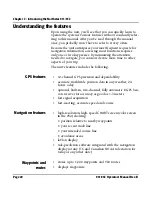
Page 26
951/952 Operator’s Manual Rev. B
Chapter 2 - Introducing the Northstar 951/952
Differential GPS
The majority of mariners use GPS in conjunction with a chart
plotter, and for any given position solution there is an error
budget. Dilution of GPS precision, errors in cartography from
both government and private sources, datum shifts, latency of
displayed position fix and so on, all compound the error in the
resulting displayed position fix. For example, imagine a chart
plotter at full-scale zoom showing a channel 200 feet wide (60
meters). A vessel navigating through that channel may well
appear to be “on the rocks” if it is 30 meters out of place!
Although this magnitude of error won’t always be the case, the
prudent navigator should choose the maximum margin of
safety. Furthermore, the precise location of bottom features for
fishing and diving is significantly degraded without DGPS, and
therefore would usually be of little use unless there’s better
than the 100 feet of accuracy (30 meters) of non-differential
GPS.
Differential corrections are generated by fixed “reference sta-
tions,” and are broadcast by marine radiobeacons over a rela-
tively limited area—usually a maximum broadcast radius of
250 miles—to differential-capable GPS (DGPS) receivers. The
precise geographic location of the reference station is used to
calculate corrections, based on the GPS data received from the
satellites. These corrections are then broadcast to DGPS receiv-
ers, which then convert this data into extremely precise posi-
tion, heading, and speed information. Referred to as “beacons,”
the transmitters are situated at various locations along the U.S.
coastline and Great Lakes, and most of them are former marine
radiobeacon sites.
Using DGPS, the 951XD/952XD—with its high-performance
12-channel GPS receiver and internal differential receiver—pro-
vides an accuracy of one to three meters 50 percent of the
time, and an accuracy of four meters 95 percent of the time.
Lat/lon positions are displayed to thousandths of minutes
(approximately six feet). When you use a radar or paper plot-
ter, DGPS corrections dramatically improve the steadiness of
your displayed plot line.
In addition to accurate positioning information, DGPS provides
critical “integrity monitoring” of the received GPS signals,
enabling a satellite problem to be corrected in seconds (as
opposed to hours using uncorrected GPS). The integrity moni-
Summary of Contents for 951
Page 6: ...Page iv 951 952 Operator s Manual Rev B ...
Page 8: ...Page vi 951 952 Operator s Manual Rev B ...
Page 10: ...Page viii 951 952 Operator s Manual Rev B ...
Page 24: ...Page 14 951 952 Operator s Manual Rev B Chapter 1 Quick Start ...
Page 40: ...Page 30 951 952 Operator s Manual Rev B Chapter 2 Introducing the Northstar 951 952 ...
Page 50: ...Page 40 951 952 Operator s Manual Rev B Chapter 3 Using the Controls ...
Page 124: ...Page 114 951 952 Operator s Manual Rev B Chapter 7 Creating Routes ...
Page 136: ...Page 126 951 952 Operator s Manual Rev B Chapter 8 Understanding Waypoint Route Navigation ...
Page 154: ...Page 144 951 952 Operator s Manual Rev B Chapter 10 Using Other Special Functions ...
Page 184: ...Page 174 951 952 Operator s Manual Rev B Chapter 11 Customizing the Unit ...
Page 188: ...Page 178 951 952 Operator s Manual Rev B ...
















































